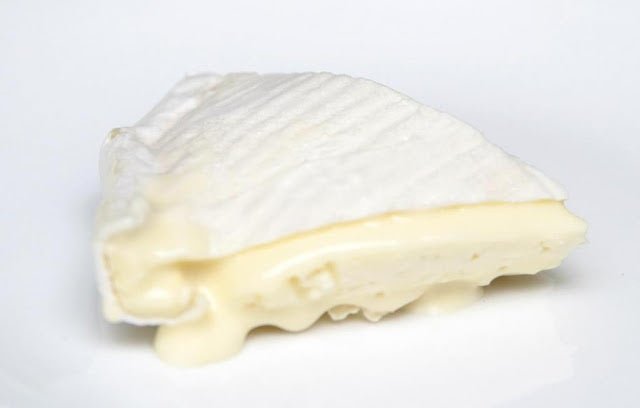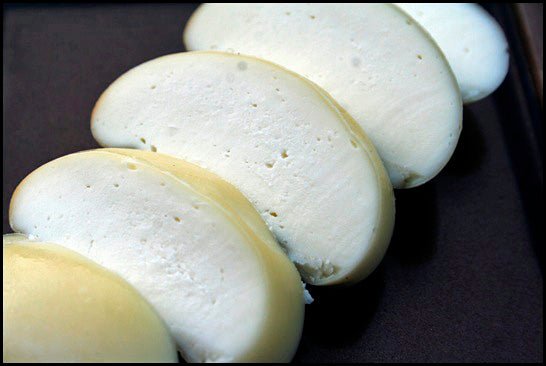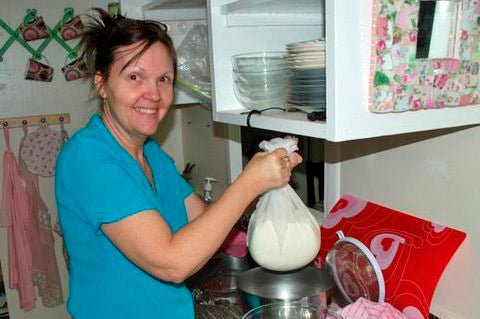This was his first attempt!
Peter Barrett has been documenting his cooking adventures since the beginning of 2006, at his website Cookblog. His skills are impressive, to say the least! In addition to being a cook extraordinaire, he is a painter, a potter, a culinary teacher and a food writer for Chronogram, an arts and culture magazine in the Hudson Valley.
His latest article in Chronogram, Cottage Industry-The Joys and Challenges of a Home-Based Food Business has some great information for any of you who might be thinking about selling your cheese at a farmer’s market, etc. The regulations might be a bit more complicated than you think.
Peter claims on his profile to have a “really great personality,” and we have to agree, because he generously agreed to share his post about the first time! he made camembert:
The Soft Parade
By Peter at Cookblog
Enough time has elapsed since the beginning of my beautiful friendship with the local raw milk source for me to finally show the evolution of one of my more impressively successful DIY endeavors: camembert. It could have aged a bit longer to reach its peak, but we had a special guest on Friday night and I needed to break it out to complete the meal (with homemade bread, of course).
Now the saga that follows actually covers a few cheeses over their various stages for maximum confusion. But I want to make clear at the outset that making this sort of cheese is every bit as easy as making feta. The only significant difference is that it needs to be aged at wine fridge temperatures rather than fridge fridge. But if you have a basement or crawl space beneath your house, a couple of plastic food storage vessels of suitable dimension will provide all of the gadgetry you require. You will, as with the feta, have to order the bacterial (and mold) cultures and rennet, and having a local source for (organic) raw or minimally processed milk is the sine qua non for this sort of operation.
Having said that, the rest is as easy as pie. Ripe, stinky pie with a gooey, slowly oozing center of creamy pale yellow goodness, that is. The process is the same: bring your milk to 86? F, the temperature that mesophilic cultures like, and add the bacteria either as dry powder or as cultured milk you saved from your last batch. Then you add some of the mold (I use two, since one helps keep the white skin that the other grows from slipping off during the occasional handling later on) and then curdle it with rennet and cut and stir the curds over an hour or so, keeping the temp fairly constant. If you haven’t yet, do click over to that feta post so you can see how this works. It’s very easy.
And then the curds go in the mold to drain and settle into the shapes we know and love. Here’s a shot of curds in my big round mold, with mats top and bottom to show how we flip it over every hour or six:
And here’s a shot of what happens after unmolding a smaller cheese from the truncated pyramid-shaped mold, complete with beautiful, glistening highlights courtesy of the kitchen window:
I unmold them once they’re firm enough to not go flop without the bolstering confines of the molds. My first effort (below) got unmolded too early, and as a result it was quite a thin disc. But see that lovely, downy, white fuzz? That’s the mold doing what it is supposed to. Once both sides are moldy-they get flipped after a few days to help that growth-it gets swaddled in cheese wrap and aged another several weeks. I sit the wrapped cheeses on top of the plastic tubs that house the moldering ones. In a month or so I’ll be using grape leaves instead, because why not?
I use this exact same technique for brie, but add the tiniest pinch of brevibacterium linens as well. This gives a reddish blush to the rind, and a characteristically footy odor to the result. You know the color from muenster (real muenster, not the rubbery simulacrum that supermarkets foist upon the microbially phobic). Technically, brie and camembert age at slightly different temperatures, but it doesn’t matter. Here’s a shot of a brie fresh out of the mold:
And here’s the same cheese, ready for wrapping, after the mold and bacteria have begun to do their work. Another few weeks of aging in the wrapper will make for mature cheese.
It’s important at this juncture to talk for a minute about how to keep this ongoing love affair with letting food go meticulously bad on the hot and heavy tip. Hygiene matters. Not OCD hose-the-kitchen-down-with-bleach-loony hygiene, but boiling the molds and mats for a minute and washing hands and counters before beginning does help improve the reliability of results. And the aging containers should be washed between batches.
But let’s not go crazy. As I have courted microbial collaboration in more and more culinary endeavors, I have learned that all the desirable microbes really need from us is a competitive advantage and they can exterminate their competition handily by generating acids and other compounds that benefit us and keep the food safe. It is, after all, what they do, and it’s why we love them.
Pickles, vinegar, wine, and cheese: these and more are all the results of us inoculating food or drink with beasts that excrete acids or alcohol or other compounds that kill their rivals and taste great to us. Often they have many health benefits as well. Embrace the unseen world. If something smells rotten, it is. Compost it and try again. But mostly things do not smell rotten if you make them halfway right and age them at a temperature where your millions of pets can do their job properly.
Something else to keep prominently in mind is that the vicissitudes of your house and climate and aging facilities are going to have an effect on the outcome. You may not end up with something that tastes exactly (or remotely) like the thing it is supposed to be emulating. So what? This is why different regions (towns, even) all have their own cheeses. If I want to call this “CamemBrie” or “Fromage de Pierre” or “Queso Gringo” or “Fred” then I will. Or I’ll feed to to my worldly friends and drive them nuts making them guess where it’s from. What matters is that it tastes like a good aged raw milk white-mold cheese, and is creamy and runny and straw-colored in the center, and lovingly coats thick slices of my crusty peasant boules like a tailored skirt that fits so well you want to lick it off.
In time, I have no doubt that variations and accidents will emerge, and the results will change and improve. But this very first try was so inspiring and exciting that I’m ready to try a bunch of new techniques this week to keep the expansion going for as long as possible. Future batches of these two cheeses will get washed with various local liquors to see how that works. Tomorrow I make salami. When the results are this good, there’s no earthly reason not to make things for yourself. Try it!






















































































































































